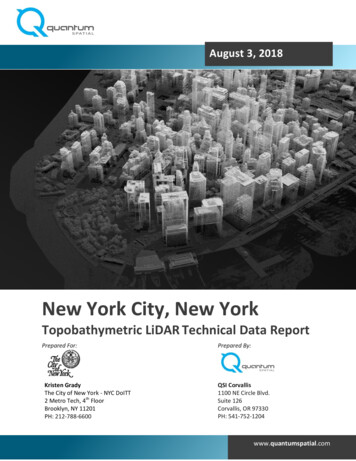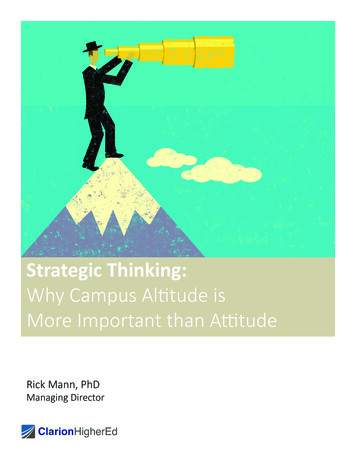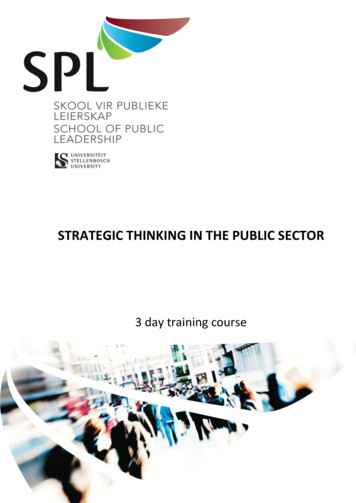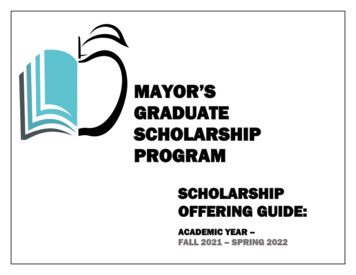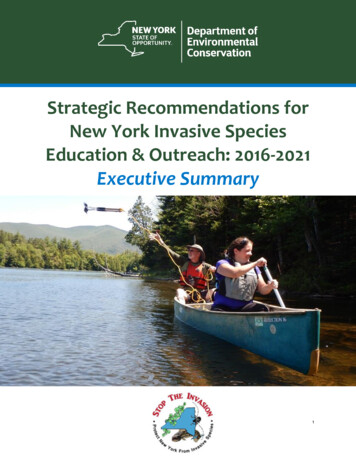
Transcription
Strategic Recommendations forNew York Invasive SpeciesEducation & Outreach: 2016-2021Executive Summary1
WHAT IS THE INVASIVE SPECIESEDUCATION AND OUTREACH STRATEGIC PLAN?The Invasive Species Education and Outreach Strategic Plan was developed toguide statewide efforts undertaken by the Invasive Species Council, AdvisoryCommittee, Partnerships for Regional Invasive Species Management(PRISMs), and their partner organizations over the next five years.A 2015 Cornell University survey indicated that about 76% of New York’sresidents are aware of the term “invasive species,” and about one third ofNew York residents “know something about” invasive species. Current andfuture generations and stewards of New York State’s natural resources needto understand the threat posed by invasive species and be actively engaged inpreventing their spread.WHAT IS THE GOAL OF THE PLAN?The overarching goal of the five-year plan is to expand New York residents’awareness of invasive species issues and willingness to adopt simplebehaviors that prevent their spread. This goal encompasses six objectives andnumerous strategic actions to be accomplished by the various components ofNew York’s comprehensive Invasive Species Program.This goal aligns with the fourth recommendation from the Invasive SpeciesTask Force’s 2005 report, which states that “New York should develop acomprehensive outreach and education program for invasive species. Itshould do so by coordinating existing effort but also exploiting opportunitiesto incorporate invasive species messages into the full variety of educationalopportunities.”1
HOW WILL WE MEET THE GOAL?Based on an assessment of previous efforts, stakeholder input, and feedbackfrom the PRISM coordinators, six objectives and associated strategic actionswere identified to help New York in meeting the goal of educating NewYorkers about invasive species issues and motivating them to take action toprevent the spread.OBJECTIVE #1: Develop messages for target user groupsidentified in stakeholder survey and Cornell three-phasestudyBased on findings from the Cornell University three-phase attitudes andawareness study (Lauber et. al, 2015) as well as feedback from stakeholders,several target user groups have beenidentified as priorities for 2016-2021.These groups include: Water gardenersAquarium ownersAgricultural communityMunicipalities (includinghighway and utility personnel)Elected officialsUrban communitiesEach of the aforementioned groups isunique not only in their membershipbut also in the ways that theiractivities may influence the spread ofinvasive species. Therefore, messageswill need to be researched andtailored to fit the needs andcommunication styles of each group.Water hyacinth is a popular plant for ornamental watergardens that causes ecological issues when introduced tonatural environments. Photo: Ted D. Center, USDA-ARS.Although spotted lanternfly has not yet been found in NY,it is of special concern to natural resource managers dueto its negative impacts on fruit trees in neighboring PA.Photo: Pennsylvania Dept. of Agriculture.2
OBJECTIVE #2: Develop and provide consistent educationand outreach products for statewide useOnce the messages have been developed and tailored to meet the target usergroups, the next step is to determine the most eff ctive means by which todeliver those messages. Some information is best conveyed through a printproduct, such as a brochure, fact sheet, infographic, or even a direct mailing.In other cases, social media, a podcast, documentary, or radio advertisementmay be more appropriate.Based on the 2015 study by Cornell University, we know that New Yorkers relyon the internet and television as their primary sources of obtaining newinformation. This fact illustrates the importance of revamping the InvasiveSpecies Clearinghouse website with a mobile-friendly user interface, languageaccessibility for non-English speakers, and a re-organization of content thatmakes the site easier to navigate.The New York Invasive Species Clearinghouse is a one stop shop forinvasive species information. User feedback will be solicited and utilizedto improve accessibility and make revisions to the current website(www.nyis.info). Watch for the user survey to become available in latespring 2017.A documentary about hemlock woolly adelgid(HWA) by filmm ker Chris Foito helped to leveragesupport for HWA monitoring and biocontrol effortsin New York State. Documentaries can be powerfultools for sharing information and motivating thepublic to become involved with an issue.3
OBJECTIVE #3: Develop & provide invasive species curriculum units aligned to New York’s science learning standardsNew P12 science learning standards for New York State will go into effect insummer 2017. A group of science education professors, teachers, biologistsand curriculum development professionals are working together to develop acomprehensive invasive species curriculum that will build upon existingresources and programs, including the iMap Invasives online database andmapping tool and an environmental DNA early detection program developedby Cornell University. Professional development workshops and webinars willbe available for educators who would like to utilize this new curriculum.OBJECTIVE #4: Promote the integration of invasive speciestopics into college/university courses and research prioritiesA need has been identified to establish a network of professors interested inincluding invasive species topics in their courses and research priorities.Engaging undergraduate and graduate students in invasive species researchhelps natural resource managers to address questions pertaining to bestmanagement practices, reproductive strategies, biological control, etc. The NewYork Invasive Species Program has existing opportunities for showcasingstudent research through the monthly PRISM webinars as well as the annualconference in Ithaca.4
OBJECTIVE #5: Support the incorporation of invasive speciesconcepts into citizen science and other informal educationprogramsCitizen scientists report thousands of invasive species observations to thestate’s online database and mapping tool, iMap Invasives, each year. Aportion of these observations are for early detection species, or invasiveplants, animals, and pathogens that are only found in a handful of locations inNew York. Natural resource managers depend on these reports to mobilize arapid response effort to eradicate, control, or contain an infestation.Incorporating invasive species information into citizen science programtrainings creates more eyes on the ground looking for and reporting species.Top left: The native common milkweed plant isrequired the endangered monarch butterfly tocomplete its life cycle, by Rob Routledge, SaultCollege.Bottom left: Japanese barberry invades aforest’s edge, by Leslie J Mehrhoff, Universityof Connecticut.Top right: Mile-a-minute weed is an earlydetection species for the state. Catching aninfestation early is key, because this plant cangrow up to six inches per day. Photo by Leslie JMehrhoff, University of Connecticut.5
OBJECTIVE #6: Increase resources dedicated to the planning,implementation & evaluation of the annual Invasive SpeciesAwareness Week campaignNew York hosts its Invasive Species Awareness Week each summer to engageresidents in invasive species-related activities and events that not onlyenhance their knowledge of the issue, but also provide participants with theresources to combat the spread of invasive species in the places that theylive, work, and recreate. During the 2016 campaign, partner organizationshosted 120 events across the state. In order to ensure that future campaignsare successful, data from feedback surveys must be collected, interpreted,and utilized to make improvements for subsequent years. Encouragingparticipation from agencies, academic institutions, not for profits, and otherpartners in each of New York’s 62 counties will bolster statewide awarenesslevels and galvanize support for invasive species management projects.Left: The Adirondack Park Invasive Plant Program (APIPP) hosted atraining during ISAW 2016 to teach highway personnel how toidentify invasive plants and prevent their spread during constructionprojects.Right: Capital Mohawk PRISM leader Laurel Gailor (left) acceptedthe award for “most water chestnut observations reported” in herPRISM region during ISAW 2016. Meg Wilkinson (right) helped tocoordinate the first year of the Water Chestnut Chasers program.6
WHO WILL IMPLEMENT THE PLAN?Successful implementation of the strategic plan can only be achieved throughbroad participation by the various components of the New York State InvasiveSpecies Program and their myriad partners:Photo: PRISM Coordinators, NY Invasive Species Research Institute, iMap Invasives, and DECInvasive Species Coordination Unit staff meet at the Albany Pine Bush in April 2016.7
HOW WILL WE GAUGE AND EVALUATE OURPROGRESS?DEC’s Invasive Species Education & Outreach Coordinator (E&O Coordinator)will maintain records of strategic actions items undertaken and will provideannual updates to the Council, Advisory Committee, and PRISM coordinators.Halfway through the five-year period, the E&O Coordinator will confer withstakeholders and determine whether objectives and/or strategic actions needto be modified in light of new developments in research, policy, or programinitiatives.A follow-up study to the 2015 Cornell University three-phase effort will beundertaken in 2020. The purpose of the study will be to gauge whethereducation and outreach eĀorts between 2016 and 2020 have had a positiveeffect on public awareness and behavior change. To ensure that meaningfulconclusions can be drawn from the follow-up survey, researchers shouldemploy survey methods and design questions that are comparable to thoseused in the original survey.HOW CAN I BE INVOLVED?Each and every citizen of New York has an important role to play in minimizingthe impacts of invasive species on our way of life. The best way to becomeinvolved at the local level is to engage with the local Partnership for RegionalInvasive Species Management (PRISM). The state’s eight PRISMs work tocoordinate invasive species management functions including recruiting andtraining citizen volunteers, establishing early detection and monitoringnetworks, implementing on the ground control and eradication projects,delivering public education and outreach, and coordinating annual work planswith their diverse partner organizations. Contact information for each PRISMcoordinator can be found in the Resources section of this report.8
Continued from previous page.Another way to join the conversation is to participate in events hosted duringthe state’s annual Invasive Species Awareness Week campaign. In previousyears events have included invasive species removal projects, documentaryfi m screenings, workshops, public presentations, guided hikes or paddlingevents, and many others! Visit http://www.dec.ny.gov/animals/105650.html forupdates and information about hosting or attending an event in your area.Top left: APIPP utilized their newdrone to take a group photograph attheir October 2016 partner meetingin Ray Brook, NY.Top right: The Finger Lakes PRISMworked with volunteers fromCornell’s Humphrey FellowshipProgram to pull water chestnut atHowland Island Wildlife ManagementArea in summer 2016. Photo byHilary Mosher.Bottom: WNY PRISM volunteersteamed up with the Western NewYork Land Conservancy to harvesthoneysuckle at the KenneglennNature Preserve during ISAW 2016.Photo by Andrea Locke.9
RESOURCES10
PARTNERSHIPS FORREGIONAL INVASIVESPECIES MANAGEMENTNew York State PRISMsInvasive species means a species that is nonnative to the ecosystem under consideration, and whoseintroduction causes or is likely to cause harm to the environment, the economy, or the health of humans. What are PRISMs?Partnerships for Regional Invasive Species Management (PRISMs), comprising diverse stakeholder groups, were createdto address threats posed by invasive species across New York State. PRISMs are key to New York’s integrated approachto invasive species management. Partners include federal and state agencies, resource managers, non-governmentalorganizations, industry, recreationists, and interested citizens. The New York State Department of EnvironmentalConservation provides financial support, via the Environmental Protection Fund, to the host organizations that coordinateeach of the eight PRISMs, resulting in statewide coverage. What Do PRISMs Do? Plan regional invasive speciesmanagement activities Implement invasive speciesprevention programs Conduct surveillance and mapping ofinvasive species infestations Detect new infestations early andrespond rapidly Implement control projects Implement habitat restorationand monitoring Educate stakeholders on invasive speciesand their impacts Coordinate PRISM partners Recruit and train volunteers Support research through citizen sciencein collaboration with the Invasive Species Research Institute http://www.nyisri.org/ Report observations to iMapInvasives http://www.nyimapinvasives.org/ Act as regional communication hubsIf you are interested in helping NY “stop the invasion,” PRISMs are a great way to get involved by volunteering formonitoring, outreach, or management projects. All are welcome to participate in statewide PRISM monthly conferencecalls to receive updates, hear excellent presentations and learn about upcoming events. Contact a PRISM leader formore information, or visit WWW.NYIS.INFOSTOP THE INVASION – PROTECT NEW YORK FROM INVASIVE SPECIES11
Regional PRISM ContactsPRISMHostContactListserve & WebsitesAPIPPAdirondack ParkInvasive Plant ProgramThe NatureConservancyBrendan Quirion518-576-2082bquirion@tnc.org cce-apipp-l-request@cornell.eduCapital MohawkCornellCooperativeExtension ofSaratoga CountyLaurel Gailor518-885-8995lrg6@cornell.edu l RegionalInvasive SpeciesPartnershipCatskill Center forConservation andDevelopmentJohn Thompson845-586-2611jthompson@catskillcenter.org cce-crisp-l-request@cornell.eduFinger LakesHobart and WilliamSmith CollegesHilary Mosher315-781-4385mosher@hws.edu cce-flprism-l-request@cornell.eduLIISMALong Island InvasiveSpecies ManagementAreaLong Island NativePlant InitiativeJoanne Klein631-560-9945liismaprism@gmail.com cce-liisma-l-request@cornell.eduLower HudsonNew York - NewJersey TrailConferenceLinda Rohleder201-512-9348lrohleder@nynjtc.org cce-hudsonprism-l-request@cornell.eduSLELOSaint Lawrence andEastern Lake OntarioThe NatureConservancyRob Williams315-387-3600rwilliams@tnc.org cce-slelo-l-request@cornell.eduWestern New YorkBuffalo StateAndrea Locke716-878-4708lockeas@buffalostate.edu cce-westernprism-l-request@cornell.edu http://adkinvasives.com/ http://www.capitalmohawkprism.org/ http://catskillcenter.org/crisp/ http://fingerlakesinvasives.org/ http://www.liisma.org/ http://lhprism.org/ http://www.sleloinvasives.org/ http://www.wnyprism.org/ How Do I Join a PRISM?For more information on PRISM meetings and activities and how you can become involved, visit the website of the PRISMin which you are interested, or contact the coordinator listed above for the PRISM.To improve communication within and among PRISMs, e-mail listserves, managed by the Cornell Cooperative ExtensionInvasive Species Program, have been established for each of the eight PRISMs. To subscribe to a PRISM listserve,e-mail the appropriate listserve address in the table above. In the subject line, type the single word “join” (without thequotes). Leave the body of the message blank; do not include a signature block or any other text in the body of the e-mail.CONTACT INFORMATIONInvasive Species Coordination UnitDivision of Lands and ForestsNew York State Department of Environmental Conservation625 Broadway, Floor 5, Albany, New York 12233-4250P: 518-402-9405 F: 518-402-9028 isinfo@dec.ny.govwww.dec.ny.gov12
New York StatePRISM Region BoundariesCLINTONFRANKLINST ENEDELAWAREULSTERDUTCHESSSULLIVANLOWER HUDSONORANGEPUTNAMROCKLANDNEW RCATTARAUGUSYATESSC HUYLERERQUEENSKINGSRICHMONDNASSCHAUTAUQUAFINGER LAKESIMRKHEMADISONK INTONLIVINGSWESTERN IDAWAYNEMONROEWESTCHEST EORLEAN STOMPNIAGARAWASHINGTONOSWEGOLIISMASUFFOLK13
New York's comprehensive Invasive Species Program. This goal aligns with the fourth recommendation from the Invasive Species Task Force's 2005 report, which states that "New York should develop a comprehensive outreach and education program for invasive species. It should do so by coordinating existing effort but also exploiting opportunities





